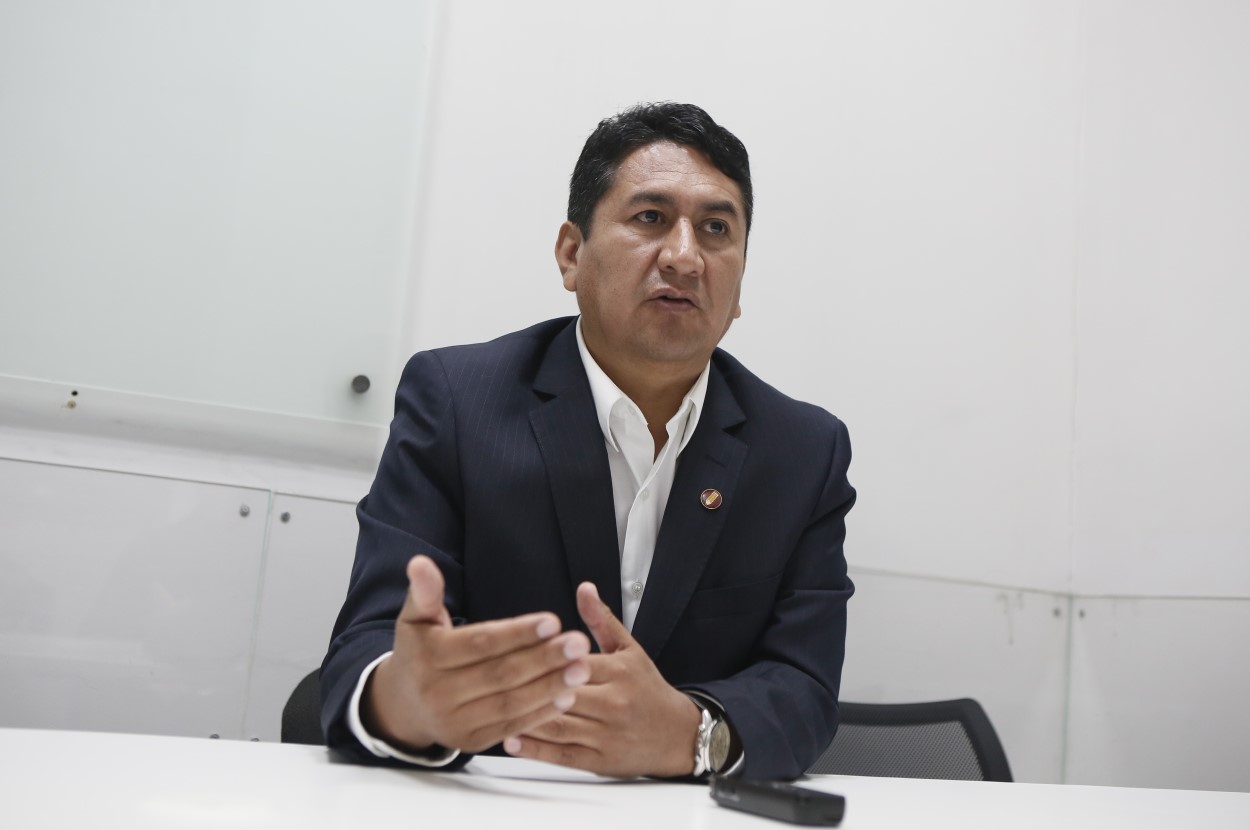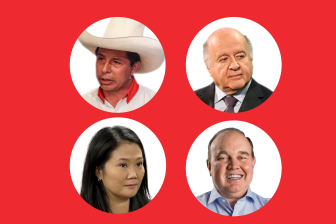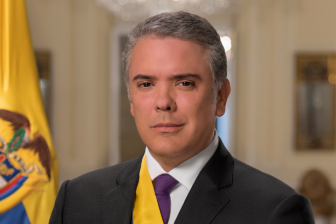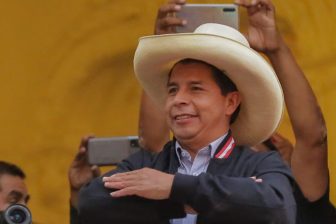He’s been called the man behind Peru’s likely next president.
As the founder and leader of the far-left party Perú Libre, Vladimir Cerrón has been described by some as the real architect of Pedro Castillo’s rise to power. For many critics, Castillo, a teacher and union leader with no experience in elected office, is just a Trojan horse for Cerrón, a Marxist former governor whose conviction on corruption charges kept him from running for president himself.
Castillo is expected to take office in July, pending official results and his opponent’s attempts to prove electoral fraud, but it’s unclear whether Cerrón will be the one really pulling the strings – or a liability for a president with little room for errors.
“Castillo has not been able to get rid of Cerrón, to his detriment” said Denisse Rodriguez-Olivari, a political scientist who studies corruption in Peru. “He’s definitely going to play a role somehow.”
A neurosurgeon who spent over a decade studying medicine in Cuba, Cerrón’s embrace of dictators there and in Venezuela has intensified worries that Peru’s next government will be part of Latin America’s anti-democratic leftist bloc. His sharing of fake news and comments considered misogynistic and antisemitic have made him unpalatable for others. His socialist economic proposals, meanwhile, have terrified business elites.
“Cerrón is a pain in the ass for Castillo,” said Renzo Cavani, a consultant and law professor. “A lot of people want Castillo to fail. Cerrón is an obstacle for him.”
Still, it’s unclear to those outside of their inner circle how close the two really are. Castillo was not Cerrón’s first choice as the party’s candidate. In a recent documentary Castillo’s wife, Lilia Paredes, described her husband’s association with Perú Libre as one of convenience for a party that needed a candidate and a candidate who needed a party.
Now, with the election over, Cerrón may have already exhausted his usefulness. In fact, Castillo has distanced himself from Cerrón since the election’s first round in April, ensuring that “the one who is going to govern is me.” Castillo tapped Pedro Francke, a former World Bank economist, as his main economic advisor. Francke has promised to respect the market economy and ruled out “massive interventionism,” but questions still linger.
“There is still a lot of speculation about Cerrón,” said Gonzalo Banda, a political analyst and professor at the Catholic University of Santa María in Arequipa. “He’s a shadowy figure.”
An affinity for Chávez
Cerrón grew up in Huancayo, a city in Peru’s central highlands, the son of university professors. In 1990, Cerrón’s father was extrajudicially kidnapped and killed because of his alleged but unproven sympathies to the communist Shining Path terrorist group, according to Peru’s Truth and Reconciliation Commission. During this year’s campaign, a doctored photo falsely purporting to show the elder Cerrón at a table with the Shining Path’s top brass went viral.
The incident underscored the fear around Cerrón’s far-left political affiliations, like his affinity for Hugo Chávez and Nicolás Maduro. Cerrón visited Venezuela in June 2019, later describing the “full markets and full stores” he saw in a Venezuela “that isn’t like the one you hear about.”
Cerrón’s views have attracted scrutiny given Castillo’s shifting stances during the campaign. For a platform, Castillo only released a 12-page plan for his first 100 days. The plan borrows some elements from a longer party manifest that Cerrón wrote in early 2020. In that document, Cerrón embraces the labels of Marxist and Leninist, promotes nationalizations of key industries and refers to Chávez, Cuba’s Fidel Castro, and Nicaragua’s Daniel Ortega as “presidents who gave dignity to the continent.”
The plan, which is critical toward the U.S., the Organization of American States, and NGOs, is “pretty outdated” and “something you might think of being from the Cold War,” said Rodriguez-Olivarri.
Castillo’s plan, meanwhile, is a more moderate version of Cerrón’s, but still “a rather radical program by Peruvian political standards,” because of its proposals to renegotiate gas contracts and develop domestic agriculture, according to El Comercio columnist Farid Kahat.
“Cerrón’s political agenda is rather radical in the sense that it seeks to reconfigure state-society relations to a significant degree,” said Michael Albertus, a political scientist at the University of Chicago.
An uncertain future
As recently as April 13, Castillo had echoed Cerrón, promising to nationalize key sectors like copper and gold. But he has since campaigned against expropriations in a move closer toward the middle visible in a new alliance with Verónika Mendoza, whose technical teams and advisors, including Francke, bolstered Castillo’s largely improvised campaign.
A former congresswoman, Mendoza tried to join forces with Cerrón in 2019 to consolidate the left ahead of 2021. But members of Mendoza’s party pushed back against Cerrón’s alleged bullying and his ties to Maduro. The alliance was canned.
Now, a struggle for influence between the socially conservative Marxist Cerrón and progressive Mendoza could influence Castillo’s trajectory.
Cerrón’s sway could hinge on his own legal future. He was scheduled to testify in a money laundering case against him on June 21, and he’s already been convicted on a prior corruption case.
In 2019, early in his second term as governor of Peru’s Junín region, Cerrón was convicted on charges akin to influence peddling and sentenced to prison for four years and eight months. An appeals judge issued a new sentence that released Cerrón from jail but ultimately kept him from seeking the presidency or vice presidency this year.
In a twist, on June 9, as the runoff vote count favored Castillo, a judge in Huancavelica, a northern region where Castillo won massive support, threw out Cerrón’s past sentences after he filed a habeas corpus petition. Peru’s judiciary quickly announced an investigation into the decision. Experts say Cerrón is not out of the woods, especially given the other cases pending against him. Indeed, the arrests on June 15 of over two dozen government employees in Junin suggest the walls may be closing in on him.
“This is not a win for Cerrón,” said Cavani, who teaches procedural law at Pontificia Universidad Católica del Perú. “His judicial situation might get worse.”
With this outlook, it makes sense that Castillo would look elsewhere for allies.
“The support Cerrón can give Castillo isn’t enough to last for four years,” political analyst Giovanna Peñaflor told AQ.
Cerrón, of course, is not without political capital of his own – his party will have the most seats in the incoming Congress. Still, its 37 legislators will make up far from a majority in the 130-seat largely right-wing legislature, and many are from Castillo’s circle. Just under half of them are teachers or who have ties to teachers.
“It’s more likely the Peru Libre caucus will be more loyal to the president of the republic than to the party president facing ongoing legal proceedings,” Fernando Vivas, a journalist at El Comercio, told AQ.
Cerrón may have noticed that his influence is not guaranteed, tweeting a veiled threat to Castillo’s new allies in Mendoza’s party. A video also circulated of Cerrón’s brother threatening Castillo to not stray from the party.
Still, as Andrea Moncada wrote in AQ, Castillo looks likely to face opposition on all fronts. That could push him away from Cerrón – or closer to him.
“The truth is I’m worried more about Castillo himself,” said Peñaflor. “Castillo is the one who will have to make decisions and it seems like he is a very isolated figure.”








